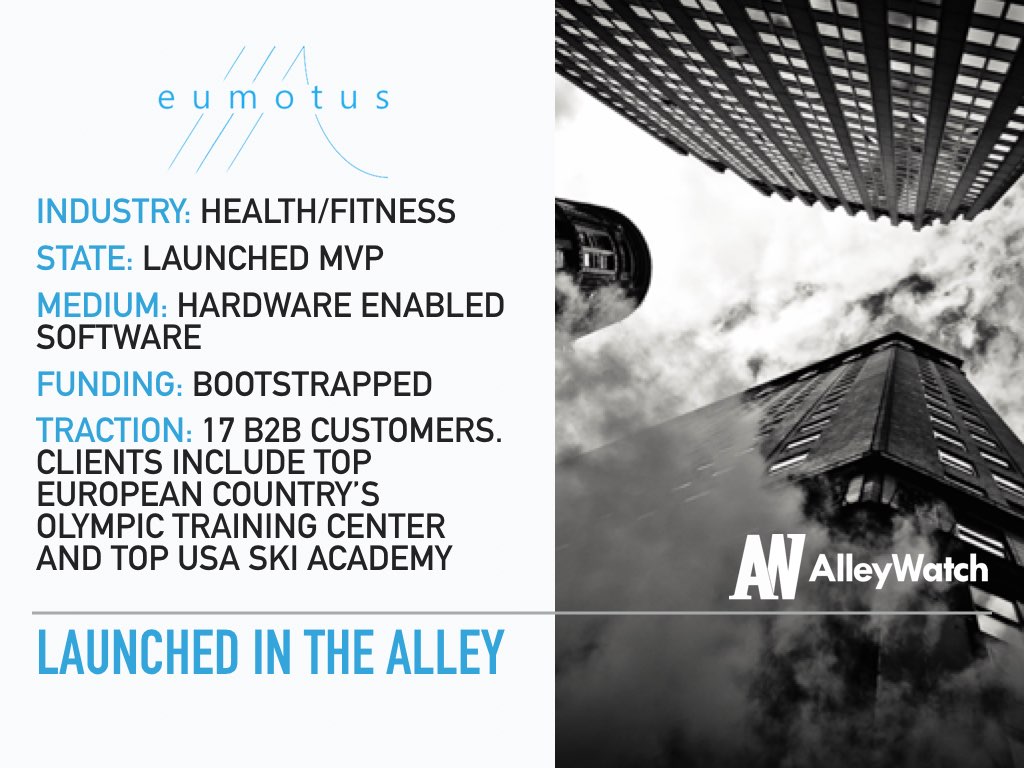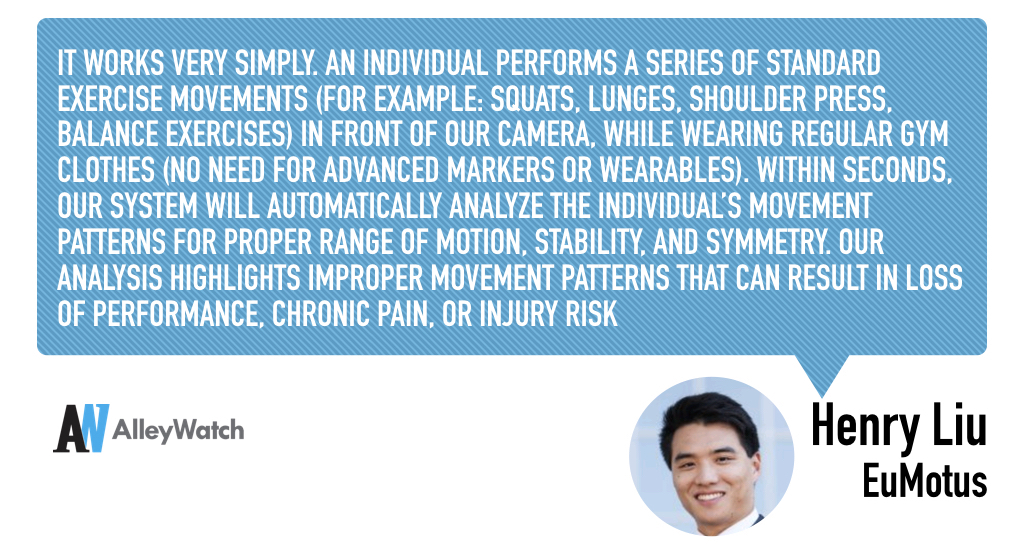With the novelty associated with wearables, to date, there have not been that many applications that truly harness the the potential to change your life for the better in an enduring way. Until now. Introducing EuMotus, a computerized movement tracking system that uses a 3d camera coupled with some sophisticated algorithms to pinpoint your movements that may be leading to injury. Currently, used by clinicians, trainers, and physical therapists in a variety of settings, the startup has its eye on the convergence of biomechanics and sports.
AlleyWatch chatted with Henry Liu about the Startup and how it came to fruition from his own injury battles.
Tell us about the product or service.
We have created a first of its kind computerized movement analysis system that uses an infrared 3D camera and proprietary algorithms to quickly and accurately capture and analyze your real-time exercise movements. Our system, called BodyWatch, is helping health and fitness professionals improve your biomechanics and physical health and reduce your risk of chronic pain and injury.
It works very simply. An individual performs a series of standard exercise movements (for example: squats, lunges, shoulder press, balance exercises) in front of our camera, while wearing regular gym clothes (no need for advanced markers or wearables). Within seconds, our system will automatically analyze the individual’s movement patterns for proper range of motion, stability, and symmetry. Our analysis highlights improper movement patterns that can result in loss of performance, chronic pain, or injury risk. We determine any potential muscle imbalances that may cause the improper movement patterns. And we propose a set of corrective exercises and stretches to improve the condition. Over time, we can easily and objectively track improvements in movement patterns to maximize a person’s physical health.
Our system is helping health and fitness professionals improve client efficacy and engagement by quantifying their physical health vitals in an objective and trackable manner. Through the use of the data and analysis we provide, therapists, coaches, and trainers are able to better communicate with their clients and provide targeted treatment and training to optimize results. Client satisfaction improves and so does retention!
Also, the speed of our assessment process improves our clients’ efficiency, so that they can spend more time communicating and working with their customers.
Lastly, our technology offers a way for our clients to differentiate their service offerings with a new and innovative methodology of care. In this way, we have been able to vastly improve our clients’ marketing power.
How is it different?
Currently, the other solutions on the market sit on two extremes: very expensive and time-consuming or inaccurate.
The very expensive and time-consuming solutions are multi-camera marker based systems. They can cost several hundreds of thousands of dollars. They require dedicated trained staff to run the system and analyze the resulting data. And they involve the time-consuming step of placing multiple markers over the body. As a result, they are not applicable to the vast majority of the population.
On the other hand of the spectrum, there are visual based systems such as the FMS, which is one of the most commonly used movement assessment systems. However, these systems rely on subjective observations and are inaccurate.
In comparison, our technology uses a single markerless 3D infrared camera, which can obtain accurate 3D biomechanical data with minimal setup and at an affordable cost. Furthermore, our algorithms and user interface design make it exceedingly easy to obtain actionable insights into physical health. As a result, anyone with basic technology literacy should be able to up and running and perform assessments in minutes. In the clinical and fitness context, making the assessment process more efficient frees up more time for communication with and treatment of the customer.
Lastly, unlike other outfits, our software goes beyond simply measuring and displaying data such as body joint locations and limb angles. Range of motion, movement stability and symmetry are all assessed against our movement knowledgebase. Probable muscle imbalance analysis is then generated through EuMotus proprietary algorithms, highlighting possible causes to poor movement patterns. Probable muscle imbalance layer brings to the attention of the clinician or fitness professional the greatest areas of concern for their customers.
What market are you attacking and how big is it?
The movement feedback market is a $120B market globally. This is driven by physical therapy clinics, the fitness/gym market and athletic training institutions.
What is the business model?
EuMotus provides BodyWatch as a monthly subscription service. We provide all the hardware necessary, as well as license to use our software. In addition, we provide all support and onboarding necessary to ensure client success. Finally, we are continuously updating the product to enhance the user experience and create value for clinicians, fitness professionals and their customers.
We believe the service business model best aligns clinician and EuMotus incentives, providing for continued customer support and product innovation.
Lastly, EuMotus is developing an additional suite of physical health analytics, which will allow clinicians and sports professionals to assess their patient’s health and against anonymized population health statistics.
What inspired the business?
Day 0: pull out of competition because of ankle sprain…hamstring strain…rotator cuff tendonitis…
Day 1: sent to physical therapy; prescribed 5-week rehab treatment
Day 7: start to feel better
Day 14: regain majority of range of motion
Day 18: rejoin team for training
Day 25: get back to competitive level…
Day 26: get injured again.
I was caught in the recurring injury loop throughout his NCAA D1 athletic career. Suffering injury after injury, I realized that something systematic was causing this vicious cycle.
Being young and impatient, I was always overeager to get back to competing. Often, my fellow athletes and I would stop our rehab programs after we “felt” better. In actuality, we had only made about 80% of a full recovery. The remaining 20% was the key difference between full functional health and relapsing into injury.
In 2014, during a routine fencing practice, I sustained a severe injury to his left ankle from which I still have not fully recovered. To this day I have not fenced since.
The issue: there was no way for trainers and therapists to easily quantify and effectively communicate the progress of their recovery.
Today, EuMotus is leveraging the latest technological advances to create systems that can help the general population move better, train smarter, and heal safer.
To solve this problem, I brought together a team passionate about improving our population’s physical health. The team consists of former NCAA D1 athletes, a US ski champion, a US Olympian and weekend warriors who have experienced injuries that have prevented them from competing and enjoying sports.
What are some interesting use cases of your technology?
Clinicians. BodyWatch’s markerless technology enables a holistic physical health analysis in minimal time and effortlessly captures otherwise hard to measure movement metrics. The service creates value by speeding up assessments up to 50%, thus allowing clinicians to spend more time communicating with and treating their customers.
Many PT patients do not follow through on their treatment program, electing to terminate their treatment prematurely. BodyWatch helps PTs mitigate this problem by getting patients excited and engaging them through the use of powerful visual communication tools.
Data are presented in intuitive and easy to understand scores and visuals. Clients have demonstrated that through BodyWatch, patients become more engaged and quickly shift from a pain to a functional health mindset. As a result, patients are better able to understand their physical health and the treatment plan prescribed by their PT. Patients that return directly impact a clinic’s revenues. Enthusiastic patients are more likely to talk about and recommend your practice to others.
Some EuMotus clients elect to charge their patients per EuMotus assessment, creating an additional revenue stream for their clinic.
Athletic Training Institutions. World-class athletic training and Olympic training centers are using EuMotus BodyWatch technology to systematically screen their athletes’ form, looking for symptoms of poor movement form linked with increased risk of injury. Trainers are tracking this progress over time to detect improvements or decreases in form.
Gyms. Services such as assessments, classes and personal training strongly drive profitability in gyms. Some gyms in the US provide movement and other physical health assessments in the high tens to low hundreds of dollars. Physical health quantification and assessment tech creates value for the gym and gym goer alike.
What are the milestones that you plan to achieve within six months?
First we want to close our seed funding round, we also want to reach 100 B2B customer a close an agreement with a strategic partner for product development or distribution.
What is the one piece of startup advice that you never got?
Given that we operate in the B2B space, we have a key advantage that we can directly ask our potential clients what they want. Leverage that. Learn as much as possible from your customer before you build something.
If you could be put in touch with anyone in the New York community who would it be and why?
Equinox CEO Niki Leondakis. We believe we can strengthen and complement the Equinox customer experience by adding a quantified performance element.
Why did you launch in New York?
New York is a highly competitive market for clinic physical therapy and athletic training services. In our experience, clinics and athletic training centers in areas with competition tend to be more open to evaluating and adopting new technologies, which help improve business and health outcomes. The New York customer expects more from local businesses.
New York is home to 13 major professional sports teams, as well as the MLB, MLS, NBA, NFL and NHL.
New York also attracts world class talent and boasts one of the top VC ecosystems in the US.
What’s your favorite restaurant in the city?
Le Gigot (West Village – 18 Cornelia St)






